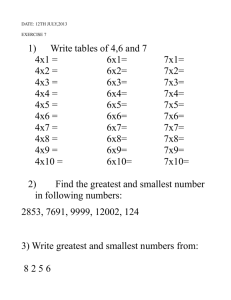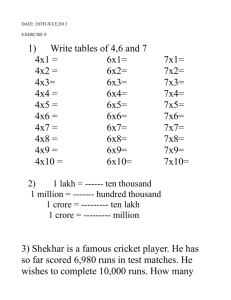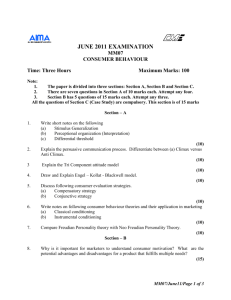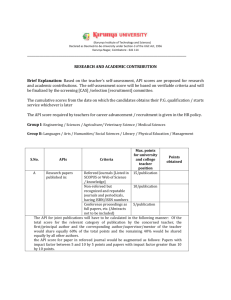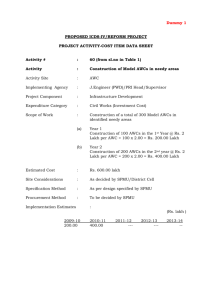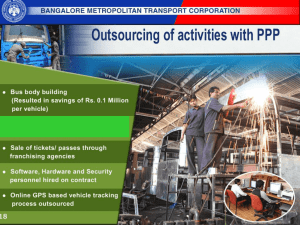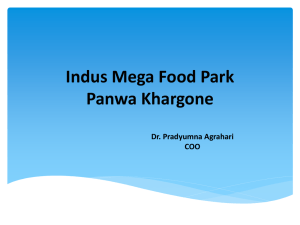Document
advertisement
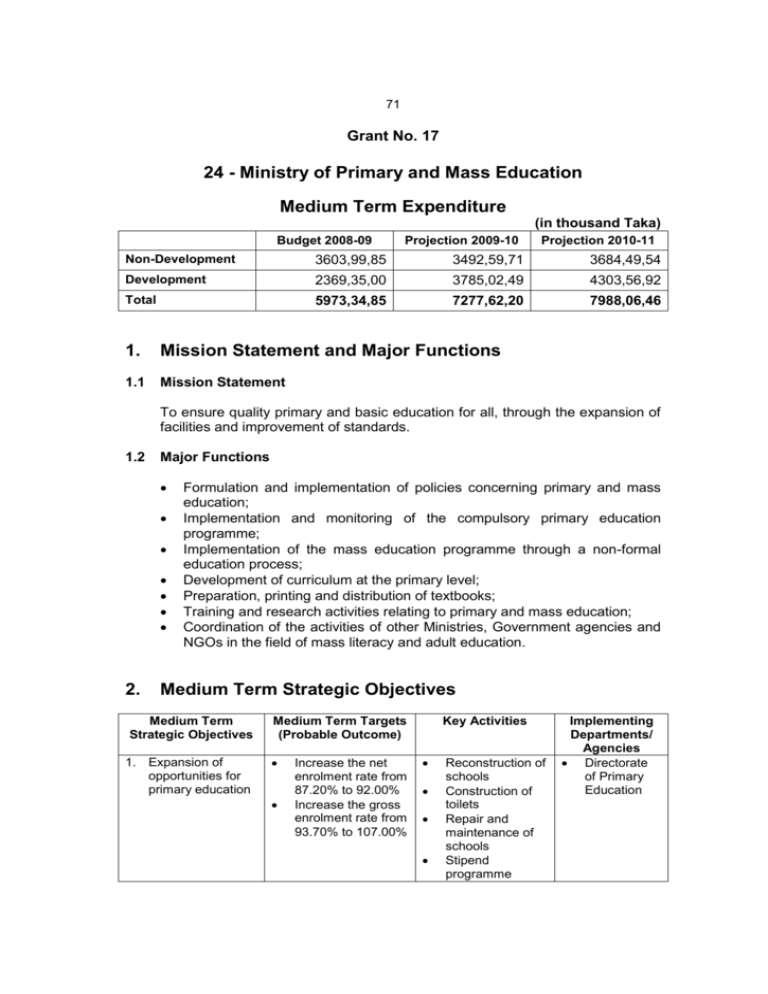
71 Grant No. 17 24 - Ministry of Primary and Mass Education Medium Term Expenditure (in thousand Taka) Budget 2008-09 Projection 2009-10 Projection 2010-11 Non-Development 3603,99,85 3492,59,71 3684,49,54 Development 2369,35,00 3785,02,49 4303,56,92 Total 5973,34,85 7277,62,20 7988,06,46 1. Mission Statement and Major Functions 1.1 Mission Statement To ensure quality primary and basic education for all, through the expansion of facilities and improvement of standards. 1.2 Major Functions 2. Formulation and implementation of policies concerning primary and mass education; Implementation and monitoring of the compulsory primary education programme; Implementation of the mass education programme through a non-formal education process; Development of curriculum at the primary level; Preparation, printing and distribution of textbooks; Training and research activities relating to primary and mass education; Coordination of the activities of other Ministries, Government agencies and NGOs in the field of mass literacy and adult education. Medium Term Strategic Objectives Medium Term Strategic Objectives 1. Expansion of opportunities for primary education Medium Term Targets (Probable Outcome) Increase the net enrolment rate from 87.20% to 92.00% Increase the gross enrolment rate from 93.70% to 107.00% Key Activities Reconstruction of schools Construction of toilets Repair and maintenance of schools Stipend programme Implementing Departments/ Agencies Directorate of Primary Education 72 Medium Term Strategic Objectives Medium Term Targets (Probable Outcome) Key Activities Education allowances and stipend for disadvantaged and drop-out students Ensure that all classrooms are friendly for boys and girls and the disabled Supply of textbooks, free of cost and in a timely fashion Inclusion of registered nonGovernment schools and community schools on the Monthly Payment Order (MPO) list Implementing Departments/ Agencies Compulsory Primary Education Implementati on and Monitoring Unit 3. Impact of Strategic Objectives on Poverty Reduction and Women’s Advancement 3.1 Expansion of opportunities for primary education Impact on Poverty Reduction: The children of poor families will receive opportunities to access primary education through stipend programmes, education allowances and infrastructural development activities for primary schools. Infrastructural development programmes for improving access to education facilities will create employment opportunities for the poor. Impact on Women’s Advancement: The infrastructure of 16,397 primary schools will be developed to provide more opportunities for access to primary education. About 32 lakh students will benefit from this initiative. Approximately 50.00% of the existing beneficiaries of primary education are girls. As a result, the varying activities and programmes undertaken to improve access to primary education will contribute to women’s advancement. Approximately 55 lakh boys and girls receive stipends under the various stipend programmes. Through the ROCH project, education allowances are given to five lakh drop out children and, as almost half of the beneficiaries are female, these programmes are contributing to women’s advancement. 73 4. Priority Spending Areas/Programmes Priority Spending Areas/Programmes Related Strategic Objectives 1. Teachers Training: Attempts have been made for qualitative improvement in education through imparting various training courses including C.in.Ed and subject based training to the teachers engaged in primary education. By 2011, C.in.Ed training will be provided to 90.00% of the teachers i.e., about 190,600 teachers. Strategic Objective Number 9 Development of the skills of teachers 2. Education Aids: The supply of different teaching materials like books, bags, supplementary reading materials etc. to the primary school students will improve the quality of education. The provision of education through appropriate processes and methods greatly contributes to improve the effectiveness of education. On average, six crore text books are distributed free of cost every year. Strategic Objective Number 1 Increased opportunities for access to primary education Strategic Objective Number 2 Improve the quality of primary education. 3. Stipend/Education Allowance: On the basis of specific guidelines, stipend and education allowances are given to the children of marginal families and disadvantaged students as opportunity cost in order to increase attendance and the completion rates for the education cycle, and eliminate the propensity for drop out. Strategic Objective Number 1 Increased opportunities for access to primary education Strategic Objective Number 3 Ensure equality and equity in the field of primary education Strategic Objective Number 4 Increase enrolment, school attendance and primary education cycle completion rates of the students of poor families 4. Post literacy Continued Education Programme: Measures are taken to increase the income of the 30 lakh newly literate persons through sharpening their literacy knowledge and by providing training in income generating activities. The beneficiaries of the training programmes are playing an important role in the overall development of their families through utilising their knowledge gained at an earlier stage in the education process. Strategic Objective Number 5 Increase literacy rates Strategic Objective Number 6 Bring dynamism in the post literacy activities through continued education programme 5. Repair, Reconstruction and Maintenance of existing Infrastructures: Child friendly infrastructures play a vital role in improving the quality of education. The work on the reconstruction of schools built in the sixties and eighties is undertaken every year to ensure that those schools that require work are made child friendly. New ideas are being used to assist in the construction of new infrastructures, for example new blackboards are now being fixed on both sides of a class room, instead of just one. Strategic Objective Number 1 Increased opportunities for access to primary education Strategic Objective Number 2 Improve the quality of primary education. Strategic Objective Number 4 Increase enrolment, school attendance and primary education cycle completion rates of the students of poor families Strategic Objective Number 3 74 Priority Spending Areas/Programmes 6. Teachers Recruitment: It is important to keep the student-teacher ratio at an appropriate level (1:30) to improve the quality of education. Presently the ratio is 1:54. Adequate numbers of teachers are recruited each year to reduce this ratio. Related Strategic Objectives Ensure equality and equity in the field of primary education Strategic Objective Number 1 Increased opportunities for access to primary education Strategic Objective Number 2 Improve the quality of primary education. 5. Functions, Key Activities and Outputs of the Departments/ Agencies under the Ministry 5.1 Directorate of Primary Education 5.1.1 Functions Increased opportunities for access to primary education Recent Achievements: During the last three years, through the implementation of development programmes aimed at improving the educational environment, the net enrolment rate has increased to 87.20%, and gross enrolment has increased to 93.70%, the teacher-student ratio is now 1:54, the student attendance rate rose to 77.00% and the number of contact hours rose to 840 hrs. In addition, through various training development programmes, 72.00% of the total number of teachers has been provided with Cin-Ed training, 18 types of supplementary reading materials have been distributed and training has been provided to 60,000 members of School Managing Committees. Future Plans: To ensure universal primary education by 2015 and guarantee quality primary education, it has been planned to raise the number of contact hours to 923 hrs by 2011, the net enrolment rate to 92.00%, achieve teacherstudent ratio of 1:46, increasing the C-in-Ed qualified teachers’ rate to 90.00%, and to improve students’ competency rate to 65.00% and attendance rate to 80.00%. 5.1.2 Key Activities and Outputs Key Activities Output Related to the Activity Related Strategic Objectives 1 Reconstruction Reconstruction of 6,397 and expansion of 10,000 schools Provision of toilets Establishment of 33,808 new toilets and sinking 16,397 tube wells Repair and maintenance Repair and maintenance of 25,000 schools on average per annum Approved Projects 75 Key Activities Output Related to the Activity Related Strategic Objectives 1. Primary Education Development Project-2 2. Repair and reconstruction of Government Primary Schools (phase 2) 3. Development of Registered Primary Schools Project ( 3rd phase) 4. Construction of Government Primary Schools-IDB assisted project Unapproved Projects 1. Construction of boundary walls for selected Government Primary Schools 2. 3rd Primary Education Development Programme Stipend payments Providing stipends to 5,500, 000 students 1,3,7 Providing education allowances and implementation of school feeding programmes for the underprivileged and dropout students Providing seven lakh students with 75 grams of biscuits everyday through the school feeding programme to raise their nutrition level 1,3,7 Providing education allowances and grants for underprivileged children and dropout students Providing education allowance and grants to 5,00,000 poor and underprivileged children Approved Projects 1. Stipend for Primary Education 2. Reaching out of school children project Unapproved Project 1. Stipend for primary education (2nd phase) Supply of text books free of cost and in a timely manner Supply of approximately six crore text books free of cost on average, per annum 1 Approved Projects 1. Primary Education Development Programme-2 Unapproved Projects 1. 3rd Primary Education Development Programme Appointment of required number of teachers Appointment of 35,000 teachers under PEDP-2 Appointment of 5,000 teachers on average, per annum through the revenue budget 2 Approved Projects 1. Primary Education Development Programme-2 Unapproved Project 1. 3rd Primary Education Development Programme Modification/revision of curriculum Modify/revise all curriculum to ensure that they are up to date 2, 3 Supply of six crore text books 2 Operational Unit Directorate of Primary Education Supply of teaching aids 76 Key Activities - Bag - Teachers guide - Box -Supplementary reading materials Output Related to the Activity Related Strategic Objectives on average, per annum Supply of various teaching aids to 1.62 crore pupils Distribution of 16 supplementary reading materials Approved Project 1. Primary Education Development Programme - 2 Unapproved Project 1. 3rd Primary Education Development Programme Construction of child friendly infrastructure Reconstruction of 6,397 and expansion of 10,000 school buildings 4 Approved Project 1. Second Primary Education Development Programme Unapproved Project 1. 3rd Primary Education Development Programme Arrange separate toilets for girl students Appoint female teachers Arrange 33, 808 toilets for girls Appoint 15, 600 female teachers 8 Approved Projects 1. Primary Education Development Programme-2 2. Reconstruction and repair of Government Primary Schools (2nd phase) 3. Development of Registered Primary Schools C-in-Ed Training By 2011, 90.00% of the teachers i.e., approximately 194,000 teachers will have benefited from C-in-Ed training Subject-based training Provide subject-based training in five subjects to 1,24,000 teachers(two teachers from each of 62,000 schools) Basic training Provide training to 186,000 members of the School Managing Committees Approved Project 1. Primary Education Development Programme-2 9 77 6. Key Performance Indicators Indicators Unit of Measurement Contact hour(average) Teacher-Pupil ratio Net enrolment rate C-in-Ed trained teachers’ rate Students learning competency Attendance rate Non-formal education programme (neo-literate) Stipend High protein biscuit distribution Admission rate in high school from primary Repair and renovation Reconstruction Subject based training Actual Targets Revised Targets Medium Term Targets Hour 2006-07 750 2007-08 898 2006-07 898 2008-09 923 2009-10 923 2010-11 923 Ratio 1 54 1 50 1 50 1 46 1 46 1 46 % 87.20 88.00 88.00 90.00 91.00 92.00 % 71.90 85.00 85.00 88.00 89.00 90.00 % 45.00 55.00 55.00 65.00 65.00 65.00 % 77.00 78.00 78.00 80.00 80.00 80.00 Person 5 lakh 9 lakh 9 lakh 9 lakh 9 lakh 12 lakh Person 55 lakh 5 lakh 55 lakh 5 lakh 60 lakh 60 lakh 60 lakh Person 55 lakh 5 lakh 7 lakh 7 lakh 8 lakh % 83.30 84.00 84.00 85.00 86.00 87.00 Number 20,000 20,000 20,000 20,000 20,000 20,000 Number Person - 12,220 - 12,220 - 8,000 72,000 6,000 40,000 2397 30,000
